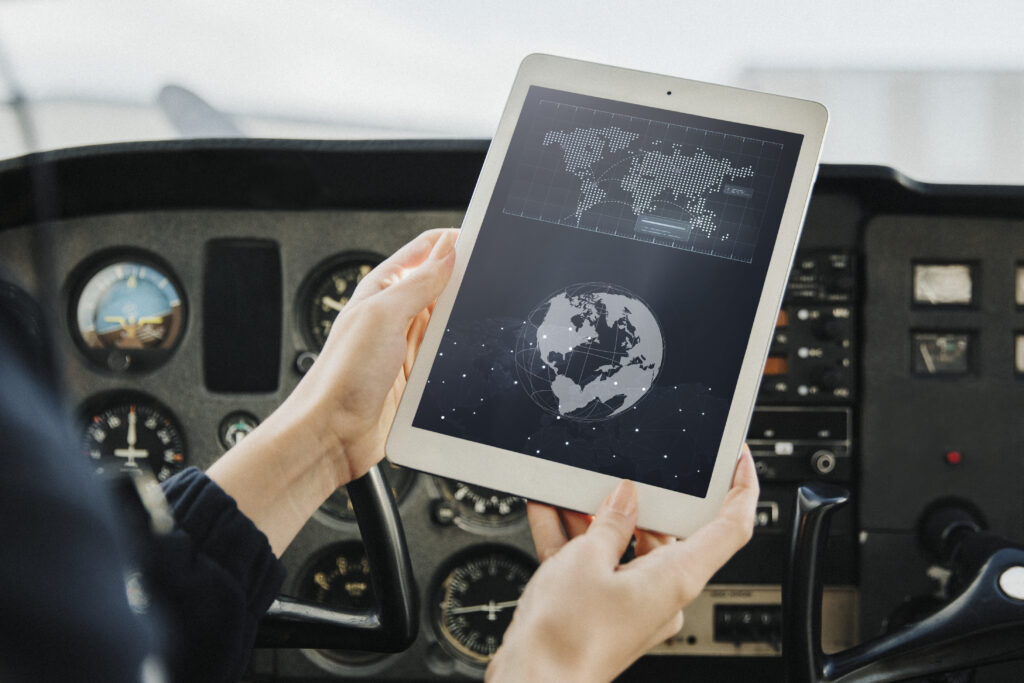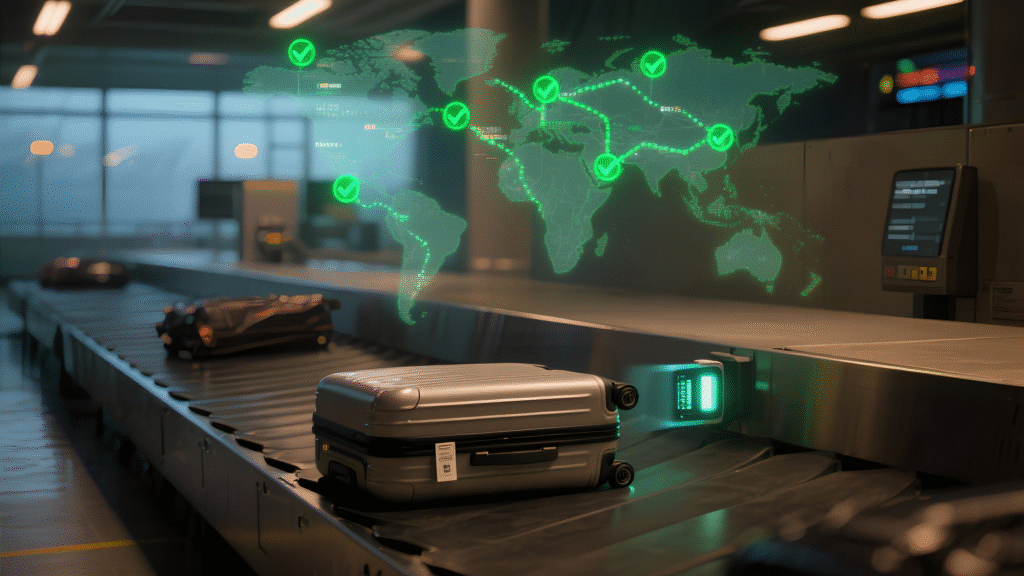Blockchain is a form of distributed ledger technology (DLT) that records data across multiple computers in a way that makes it virtually impossible to alter retroactively. Each transaction or data entry, known as a “block”, is securely linked to the one before it, forming a continuous, time-stamped “chain”. Every participant in the network holds an identical copy of this ledger, ensuring transparency, traceability, and integrity without reliance on a single central authority. Originally developed to support digital currencies, blockchain has evolved into a trusted data-management framework used in sectors requiring high levels of verification and auditability. Its capacity to ensure that records are both tamper-proof and verifiable has made it particularly attractive across a range of industries like finance, healthcare, and aviation.

Why Blockchain Matters for the Aviation Industry
Blockchain promises immutability, cryptographic trust and permissioned sharing across participants. For aviation, an industry governed by safety standards, multiple stakeholders and complex supply chains, those qualities look useful on paper. The practical question for stakeholders is whether blockchain can materially improve compliance and personnel verification of licenses, certificates, and training records without creating new operational, privacy or cost burdens.
Aviation compliance rests on two facts: documents move in paper-based or siloed digital systems, and multiple parties must trust that records are authentic and complete. However, international studies indicate that up to 60% of aviation documents, such as licences, certificates, and training records, still exist in paper format or isolated digital systems. Because of this, airlines lose hundreds of millions of USD annually due to verification delays and other documentation inconsistencies.
Gaps in traceability can also open the door to fraud, counterfeit parts and missed compliance steps, whilst also making due diligence slow and expensive when staff move between jurisdictions. Blockchain’s strongest technical benefit is a tamper-evident audit trail that can be cryptographically verified by many parties without exposing underlying personal data. In use cases where provenance, one-version-of-truth and offline verification matter, blockchain can reduce verification time and the human effort required for audits.
“In aviation, compliance and verification are fundamental to safety,” says AERVIVA CEO Mindaugas Rainys. “Blockchain introduces a layer of trust that is both technological and procedural. It ensures that every credential, entry, and certification can be authenticated instantly, anywhere in the world.”
The aviation industry is already running meaningful pilots. SITA’s solution with ICAO demonstrated an offline, privacy-preserving mechanism for verifying electronic personnel licences and helped define technical building blocks for a global EPL standard. That project showed verification is possible without exposing personal data or requiring continuous network access, offering a practical solution for many airports.
IATA’s white paper and digital identity work, treats blockchain and decentralized identifiers as enablers for trusted, portable credentials for both staff and passengers. IATA is actively piloting identity verification constructs that build on these concepts for staff authentication across distribution and operations channels.
Market sentiment data from industry surveys supports the interest, with it being reported that roughly 59% of airlines planned pilot or research programmes around blockchain by 2021, up from 42% the prior year, a clear indicator that blockchain has begun being priority research for many operators. That momentum continued up to and throughout 2025 as projects scale and move into other areas of aviation, such as Air Traffic Management.

Where blockchain delivers clear ROI
Blockchain is increasingly proving its value in aviation by driving efficiency. Its ability to eliminate manual processes, reduce fraud, and streamline compliance workflows positions it as one of the most transformative digital tools in modern aviation.
- Electronic personnel licenses recorded on a blockchain allow regulators and employers to verify authenticity in seconds. By embedding cryptographic signatures within an immutable ledger, blockchain ensures that credentials cannot be forged or duplicated. This concept revealed that this approach could drastically reduce manual verification time, particularly for cross-border staff and contractors, as what used to take 72 hours to verify, is now down to as little as 7 seconds.
- Maintenance logs and aircraft part histories are vital to aviation safety, and counterfeit or poorly documented parts pose both safety and regulatory risks. In fact, the ICAO and FAA report that poorly documented critical aircraft parts have been a contributing factor in more than 21 aviation incidents over the past two decades. Now, blockchain enables a transparent supply chain that links part manufacture, shipment, installation and maintenance activity, which shrinks investigation time after an incident and can make audits far more efficient.
- In aviation HR, credential portability (training, type ratings, medical certificates) is operationally valuable for staffing agencies, crew rostering and cross-border contractors. A permissioned blockchain network allows verified credentials to travel with the individual, removing redundant checks. This not only expedites hiring but also improves regulatory confidence that the data has not been manipulated.
- Blockchain’s utility in aviation extends beyond personnel and maintenance into everyday operational domains such as baggage handling. By recording every scan and custody transfer of a checked bag on a shared ledger accessible to airlines, ground handlers and airports, blockchain offers a single truth of bag-movement history. This transparency enables faster resolution when baggage is delayed or misrouted, reduces labour costs associated with tracing missing bags, and improves passenger satisfaction. Industry commentary reports that up to 42% of mishandled bags relate to transfer delays, and blockchain-augmented tracking systems are cited as a key tool to reduce those incidents.
- Another use lies in air traffic control. Researchers at NASA developed an open-source permissioned blockchain framework to enable aircraft privacy and anonymity while providing a secure and efficient method for communication shared among authorized stakeholders.

“Blockchain is about future-proofing aviation operations and ensures compliance standards are upheld” notes AERVIVA CEO Mindaugas Rainys. “As we digitize more of the aviation ecosystem, technologies that ensure integrity and transparency will define who leads the next era of safe, data-driven aviation.”
While blockchain’s potential is significant, its implementation must be carefully controlled. The most important caveat is the “garbage in, garbage out” problem: blockchain only guarantees the integrity of stored data, not its truthfulness. If fraudulent information is entered, the blockchain will preserve it immutably. Hence, robust identity verification and notarization procedures must precede data entry.
Privacy and governance present further challenges. Aviation data, especially personnel records, are protected under GDPR and similar privacy frameworks. Storing personal information directly on a blockchain could breach these regulations. Therefore, most implementations use off-chain storage, with only hashed references or metadata written to the ledger.
Finally, operational complexity and cost cannot be ignored. Establishing a global, multi-party blockchain network requires coordination among regulators, airlines, and manufacturers. The benefits are only realized once a critical mass of participants adopt the system.
Conclusion
Blockchain can be a powerful tool for aviation; the technology’s immutability and decentralized verification cuts reconciliation time, limits opportunities for tampering, and supports auditability. Early industry-led proofs-of-concept confirm real operational benefits while also highlighting the governance and legal work required for production rollout. For safety-driven industries like aviation, the right approach is pragmatic: pilot, measure, secure, and scale only where tangible ROI and regulatory acceptance exists.

